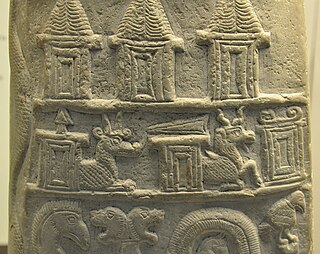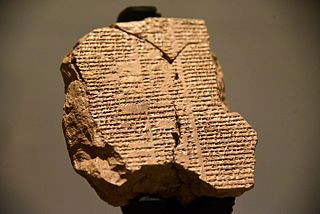
Marduk is a god from ancient Mesopotamia and patron deity of Babylon who eventually rose to power in the 1st millennium BC. In Babylon, Marduk was worshipped in the temple Esagila. His symbol is the spade and he is associated with the Mušḫuššu.
Nammu was a Mesopotamian goddess regarded as a creator deity in the local theology of Eridu. It is assumed that she was associated with water. She is also well attested in connection with incantations and apotropaic magic. She was regarded as the mother of Enki, and in a single inscription she appears as the wife of Anu, but it is assumed that she usually was not believed to have a spouse. From the Old Babylonian period onwards, she was considered to be the mother of An (Heaven) and Ki (Earth), as well as a representation of the primeval sea/ocean, an association that may have come from influence from the goddess Tiamat.

In Mesopotamian religion, Tiamat is the primordial sea, mating with Abzû (Apsu), the groundwater, to produce the gods in the Babylonian epic Enûma Elish, which translates as "when on high." She is referred to as a woman, and has—at various points in the epic—a number of anthropomorphic features and theriomorphic features.

In the Babylonian epic Enuma Elish, Kishar is the daughter of Abzu and Lahmu, the first children of Tiamat and Abzu. She is the female principle, sister and wife of Anshar, the male principle, and the mother of Anu. Kishar may represent the earth as a counterpart to Anshar, the sky, and can be seen as an earth mother goddess. Her name also means "Whole Earth".
Belili was a Mesopotamian goddess. This name refers both to a sister of Dumuzi known from some of the texts pertaining to his death, and to a primordial deity paired with Alala and listed in enumerations of ancestors of Anu. There is no consensus among researchers if they should be considered one and the same.

Enūma Eliš, meaning "When on High", is a Babylonian creation myth from the late 2nd millennium BCE and the only complete surviving account of ancient near eastern cosmology. It was recovered by English archaeologist Austen Henry Layard in 1849 in the ruined Library of Ashurbanipal at Nineveh. A form of the myth was first published by English Assyriologist George Smith in 1876; active research and further excavations led to near completion of the texts and improved translation.
Anshar was a Mesopotamian god regarded as a primordial king of the gods. He was not actively worshiped. He was regarded as the father of Anu. In the first millennium BCE his name came to be used as a logographic representation of the head god in the Assyrian state pantheon, Ashur. He is attested in a number of god lists, such as An = Anum, and in literary compositions, including the Enūma Eliš.

Laḫmu is a class of apotropaic creatures from Mesopotamian mythology. While the name has its origin in a Semitic language, Lahmu was present in Sumerian sources in pre-Sargonic times already.
Mummu was a Mesopotamian god. His name is presumed to be derived from the Akkadian word mummu, "creative force". In addition to functioning as a theonym, it is attested as a title of multiple other deities highlighting their respective roles as creators. Ritual texts indicate that Mummu was perceived as an inactive figure, similarly to deities such as Enmesharra or Qingu.
Ancient Semitic religion encompasses the polytheistic religions of the Semitic peoples from the ancient Near East and Northeast Africa. Since the term Semitic represents a rough category when referring to cultures, as opposed to languages, the definitive bounds of the term "ancient Semitic religion" are only approximate but exclude the religions of "non-Semitic" speakers of the region such as Egyptians, Elamites, Hittites, Hurrians, Mitanni, Urartians, Luwians, Minoans, Greeks, Phrygians, Lydians, Persians, Medes, Philistines and Parthians.
Enbilulu was a Mesopotamian god associated with irrigation, and by extension with both canals and rivers. The origin of his name is unknown, and there is no agreement among experts in which way he was related to the similarly named deities Bilulu and Ninbilulu. While originally an independent deity, he eventually came to be seen as a name of Marduk and is mentioned in this role in the Enūma Eliš.

The following is a family tree of gods and goddesses from Babylonian mythology.
Enmesharra was a Mesopotamian god associated with the underworld. He was regarded as a member of an inactive old generation of deities, and as such was commonly described as a ghost or resident of the underworld. He is best known from various lists of primordial deities, such as the so-called "theogony of Enlil," which lists many generations of ancestral deities.
Kakka was a Mesopotamian deity. She was originally worshiped across Upper Mesopotamia as a healing goddess, but later on came to be secondarily viewed as a male messenger god in Babylonia. Kakka's oldest attested cult center is Maškan-šarrum, located in the south of Assyria, though she was also worshiped in the kingdom of Mari, especially in Terqa. She appears in numerous theophoric names from this area, with Akkadian, Amorite and Hurrian examples attested. As early as in the Old Babylonian period she could be associated with Ninshubur, and later on with Papsukkal as well. However, she developed connection with Ninkarrak, Išḫara and possibly Nisaba as well. The male form of Kakka appears as a messenger of Anu in the Sultantepe version of the myth Nergal and Ereshkigal, and as a messenger of Anshar in Enūma Eliš.

Anu or Anum, originally An, was the divine personification of the sky, king of the gods, and ancestor of many of the deities in ancient Mesopotamian religion. He was regarded as a source of both divine and human kingship, and opens the enumerations of deities in many Mesopotamian texts. At the same time, his role was largely passive, and he was not commonly worshipped. It is sometimes proposed that the Eanna temple located in Uruk originally belonged to him, rather than Inanna, but while he is well attested as one of its divine inhabitants, there is no evidence that the main deity of the temple ever changed, and Inanna was already associated with it in the earliest sources. After it declined, a new theological system developed in the same city under Seleucid rule, resulting in Anu being redefined as an active deity. As a result he was actively worshipped by inhabitants of the city in the final centuries of the history of ancient Mesopotamia.
Alalu or Alala was a primordial figure in Mesopotamian and Hurrian mythology. He is also known from documents from Emar, where he was known as Alal. While his role was not identical in these three contexts, it is agreed that all three versions share the same origin. Hurrian Alalu, who plays the role of the oldest king of gods in the Kumarbi Cycle, is the best known, and is commonly discussed in scholarship focused on comparative mythology but it is agreed Mesopotamian Alala represents the oldest tradition regarding this being. However, the precise etymology of his name is unknown, and likely neither Sumerian nor Semitic. Both Hurrian and Mesopotamian sources attest an association between him and Anu, but its nature varies between cultures.

Bašmu or Bashmu was an ancient Mesopotamian mythological creature, a horned snake with two forelegs and wings. It was also the Akkadian name of the Babylonian constellation (MUL.DINGIR.MUŠ) equivalent to the Greek Hydra. The Sumerian terms ušum and muš-šà-tùr may represent differing iconographic types or different demons. It is first attested by a 22nd-century BC cylinder inscription at Gudea.

Mesopotamian mythology refers to the myths, religious texts, and other literature that comes from the region of ancient Mesopotamia which is a historical region of Western Asia, situated within the Tigris–Euphrates river system that occupies the area of present-day Iraq. In particular the societies of Sumer, Akkad, and Assyria, all of which existed shortly after 3000 BCE and were mostly gone by 400 CE. These works were primarily preserved on stone or clay tablets and were written in cuneiform by scribes. Several lengthy pieces have survived erosion and time, some of which are considered the oldest stories in the world, and have given historians insight into Mesopotamian ideology and cosmology.

Cosmology in the ancient Near East (ANE) refers to the plurality of cosmological beliefs in the Ancient Near East, covering the period from the 4th millennium BC to the formation of the Macedonian Empire by Alexander the Great in the second half of the 1st millennium BC. These beliefs include the Mesopotamian cosmologies from Babylonia, Sumer, and Akkad; the Levantine or West Semitic cosmologies from Ugarit and ancient Israel and Judah (the biblical cosmology); the Egyptian cosmology from Ancient Egypt; and the Anatolian cosmologies from the Hittites. This system of cosmology went on to have a profound influence on views in early Greek cosmology, later Jewish cosmology, patristic cosmology, and Islamic cosmology (including Quranic cosmology). Until the modern era, variations of ancient near eastern cosmology survived with Hellenistic cosmology as the main competing system.

Babylonian Religion and Mythology is a scholarly book written in 1899 by the English archaeologist and Assyriologist L. W. King (1869-1919). This book provides an in-depth analysis of the religious system of ancient Babylon, researching its intricate connection with the mythology that shaped the Babylonians' understanding of their world. It examines the psychism and thought processes of the Babylonian people, covering the main beliefs that were central to their lives and culture. The book aims to explain the foundational myths and religious practices that played a significant role in Babylonian civilization.






